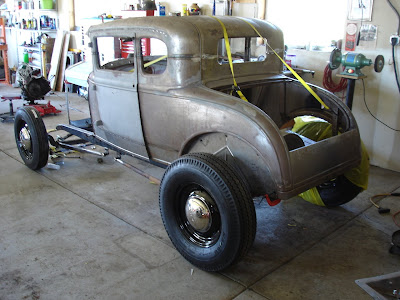
Stance is the big issue now. I need to determine where and how I want the body to sit in relation to the wheels, frame and wishbones. And one must actually put stuff together in order to really see the pieces relate. This is why the wheels and tires are connected to the axles, and axles are being set to their fore/aft positions. I can then begin to determine ride height goals and possibilities concerning the springs and frame. I am now at the stage where I can see how far I can alter the parts I have to make the car's rake.
The wheels are Wheel Vintiques 16x4.5" front and back. This is how I want them to look. I painted them with single stage Martin Senor urethane that Brian's Auto Napa mix for me. It is excellent paint. The tires are 7.50x16 Nanco rears, with a perfect traditional tread and pie crust edge. (And these tires are WAY cheaper than original reproductions of the same size). The fronts are the B.F. Goodrich 5.50x16 Long Miler that Coker sells. These are a little taller than the 15- inchers on the Model T roadster, and I chose this because the A coupe body is bigger mass. It needs a better (bigger) proportioned tire/wheel combo to match up like the little coupes from the '40s and '50s did.

Above shows the rear Model A spring, with alternating leaves removed, before I installed it on the axle. It ends up still much too tall, which required more ideas...

Here is what started as Speedway's rear spring weld-on perch. I had to severely cut and shorten the perches, and then add new plate to them for proper fit on the '64 GM A-body rear end. This ended up being a perfect width rear, and I am planning to use the lower control arm brackets to connect to the wishbones. These modified spring perches now sit as close to the axle as possible without allowing the spring eye to bottom out. And the perches are spaced at 49.5 inches, which is where they are on the original A axles.

After trying to make the rear spring set the car lower by removing leaves, I realized it wasn't enough. The Bishop/Tardell book shows the rear Model A spring main leaf reversed. So I decided to give it a try. Above shows the pattern traced on the floor of the main leaf before reversing, and the reversed leaf. I simply used my shop press for two full hours of slight bending, checking, bending, checking... And the end result is a good piece! After installing the rear spring wih the reversed main leaf, the frame sat much closer to "proper" in relation to the axle.
 After lining up where I will locate the springs, I cobbled everything together and wheeled the little body over to the chassis. It may seem too high, but it is about right where I want it. With the actual sprung weight of the completed car, the rear should sit about 1" lower. All in all, I like the high look. This is no rat rod; it is a "cute" rod! There, I said it. And stop laughing...!
After lining up where I will locate the springs, I cobbled everything together and wheeled the little body over to the chassis. It may seem too high, but it is about right where I want it. With the actual sprung weight of the completed car, the rear should sit about 1" lower. All in all, I like the high look. This is no rat rod; it is a "cute" rod! There, I said it. And stop laughing...!




